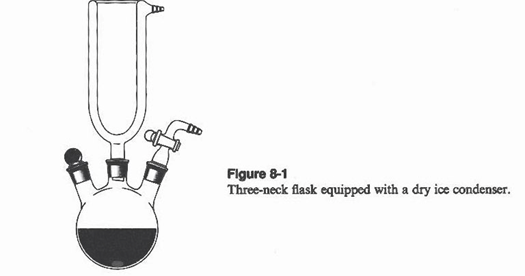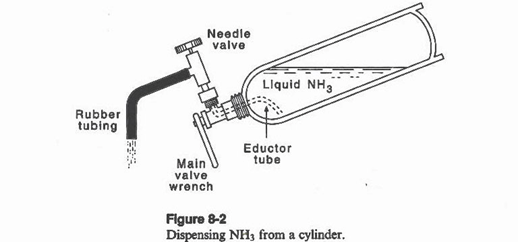8: Ph₂PCH₂CH₂PPh₂ and NiCl₂(dppe) (Experiment)
- Page ID
- 127268
This experiment is from the textbook (pages 85-92). Further information and background information can be found there. The experiment is copied here verbatim for ease of use during lab.
Notes
The adapter on the right arm of the 3-neck flask is not necessary. Just replace it with a plug. Allow a TA to assist in transferring the ammonia. Do this before adding the dry ice. The oil in the bubbler may suck back when you add the dry ice. If that happens, disconnect the bubbler.
Add the NH4Br slowly, or the NH3 will bubble up too vigorously.
Don’t try too hard to extract hard crude product from the flask. The flask would probably break and it is expensive.
Leftover product should be given to the TA.
Safety Notes
Be sure to use a fume hood for this experiment. Do not inhale ammonia fumes!!
Read all of the safety warnings in the text for this experiment.
Ni complexes are carcinogens.
Waste disposal
Sodium metal waste should be disposed of as described in the text. Anhydrous isopropanol will be available for disposal. Ask your TA what to do with the alkane that was used to prepare the sodium. Place the remaining waste in the experiment 8 waste container.
Spectra
1. Acquire the 1H NMR spectrum of dppe in CDCl3. Acquire the 31P{1H} NMR spectrum of dppe. To get a good 31P spectrum, use 40-50 mg of material dissolved in about 0.5 mL of CD2Cl2. Get at least 256 scans, which takes about 10 min. We use the same solvent (CDCl3) for both the 1H NMR and the 31{1H} NMR.
2. Acquire the IR spectrum of dppe.
3. UV-Vis measurements of NiCl2(dppe). A spectrum in the range of about 320–800 nm should be measured in dichloromethane solution.
4. Acquire the 1H NMR spectrum of NiCl2(dppe) in CDCl3. Also acquire the 31P{1H} NMR spectrum
Experiment
Safety note: Liquid ammonia is a very volatile, irritating, and toxic material; all operations involving it must be conducted in a hood. Wear rubber gloves whenever handling liquid NH3. Although ammonia has a low boiling point (-33°C), its heat of vaporization is sufficiently high that it can be dispensed into the reaction flask without external cooling. Solutions of sodium in liquid ammonia are so reducing that they carbonize Teflon-coated stir bars; it is therefore necessary to use a glass-covered stir bar. The large amount of NH3 gas evolved during the operation serves as a protective atmosphere so that it is not necessary to flush the reaction with N2.
Sodium-Liquid NH3 Solution
Equip a 500-mL three-neck round-bottom glass with a glass covered magnetic stir bar (Caution: Rapidly agitated glass stir bars tend to break though round bottom flasks). Attach a dry ice condenser to the central neck, attach the condenser to a bubbler (see Fig. 8-1), but leave one neck unstoppered for now. Lubricate all joints with silicone grease.
The next step is to put liquid NH3 into the flask. Ammonia cylinders contain a mixture of liquid gas, and which of these comes out of the cylinder depends on how the cylinder is oriented. The larger NH3 cylinders usually are fitted with a goose neck educator tube as shown in Figure 8-2. With the cylinder tipped and the outlet of the main valve pointing upward, the educator tube will be immersed in the liquid NH3. (Smaller cylinders without educator tubes may simply be tipped at a greater angle.) In this way, liquid NH3 is dispensed from the cylinder directly into the reaction flask. This procedure is by far the best way to obtain the 200mL needed for the reaction flask. This procedure is by far the best way to obtain the 200mL needed for the reaction. (Do not try to obtain the liquid NH3 by cooling the gas with a dry ice condenser. This latter method will condense enough water from the air to spoil the reaction in the next step.) We use an additional 3-neck flask to distill liquid ammonia in 2018 spring. (Reaction without distillation failed. Possibly due to water in liquid ammonia.)

Delivery of the liquid NH3 from the cylinder may be accomplished though a rubber tube inserted into the open neck of the flask. After positioning the cylinder as shown in figure 8-2, open the main valve (Remember, this is only an on off valve). Regulate the flow of liquid NH3 by adjusting the needle valve. Introduce approximately 200mL of liquid NH3 into the flask, after the NH3 has been added to the reaction flask, close the needle valve and main valve on the NH3 cylinder, and stopper the third neck of the flask. The ammonia that remains in the transfer tube should be allowed to evaporate in the hood.
Charge the condenser to one-quarter full with 95% ethanol and then cautiously add pieces of dry ice. The dry ice condenser prevents the loss of very volatile solvents so long as their boiling points are greater than -78°C, which is the sublimation point of the solid carbon dioxide. Do not allow the ethanol to spill into the reaction flask. During the course of the reaction, an insulating coating of ice should be allowed to accumulate on the outside of the reaction flask. Monitor the amount of dry ice in the condenser and add more than necessary.
Weigh out 2.3g (0.1mol) of solid in the following way. Remove a piece of sodium from the oil in which it is stored, and use a paper towel to soak up most of the oil that remains on the sodium lump. Do not use sodium that has developed a thick white coating of NaOH; instead, choose a piece that appears grey. On a paper towel, cut the sodium into small pieces and weigh the sodium by adding the pieces to a tared beaker containing heptane or similar nonvolatile alkane. It is important that you accurately weigh out the Na, but it is not important that this amount be exactly 2.3 g. Adjust the amount of the other reagents in accordance with the amount of Na used. Remove one of the stoppers on the three-neck flask and add 2.3g (0.1mol) of the freshly cut sodium metal. Replace the stopper. After approximately 10 min, the sodium dissolves completely to give a deep blue solution, which should be used immediately in the next step.
Dispose of any unwanted sodium scraps by adding them to a small beaker an anhydrous isopropanol, which reacts with sodium to form H2 and NaOC3H7. After the sodium has completely reacted, the alcohol solution may be washed down the drain with a flush of water. Do not discard sodium metal in a waste basket or sink.
1,2-Bis(diphenylphosphine)ethane, (C6H5)2PCH2CH2P(C6H5)2 (dppe)
Add 13.1g (0.05mol) of solid triphenylphosphine to the Na-NH3 solution. The addition should be done in five portions over the course of a few minutes to minimize the frothing of the reaction. The solution changes from blue to the red-orange color characteristic of the NaPPH2. By gripping the necks of the flask, gently swirl the solution to dissolve any sodium that has deposited on the upper walls of the flask. After 30 minutes, cautiously add 4.9g (0.05mol) of dry NH4Br to the reaction mixture with stirring. Prepare a solution of 2.47g (0.025mol) of 1,2-dichloroethane in 20mL of anhydrous ether. Add this solution to the orange NaPPh2 solution and allow the mixture to stir for at least 10 minutes. Finally, remove the dry ice condenser, and allow the resultant pale orange mixture to evaporate quickly – simply leave the flask unstoppered in the hood until the next laboratory period.
To work up the reaction, add 100mL of water and 75mL of dichloromethane to the flask; stir the mixture well to dissolve most of the solid. Pour the two-phase mixture into the searatory funnel. Rinse the reaction flask with some additional dichloromethane and add this washing to the separatory funnel; drain the organic (lower) phase into a 250-mL round-bottom flask and dilute it with 100mL of 95% ethanol. Concentrate this solution on a rotary evaporator to a total volume of a bout 75mL. Filter off the colorless microcrystals (see Figure 13.1), wash them with a little ethanol, and allow them to air dry. Recrystallize the product by dissolving it in dichloromethane and, if necessary, filtering the solution to remove any solids. Dilute the dichloromethane solution with an equal volume of 95% ethanol and concentrate the mixture to about one-third its volume in a rotary evaporator. Collect the resulting crystals by filtration. Record the melting point.
Dichloro[1,2-bis(diphenylphosphino)ethane]nickel(II), NiCl2 (dppe)
Prepare a solution of 0.320g (1.34mmol) of NiCl2 ·6 H2O in 50mL of 95% ethanol. To this green solution add 0.54g (1.34mmol) of dppe. After the mixture has stirred for a few minutes, the product is fully formed and can be collected by filtration. Wash the orange solid with 20mL of diethyl ether to remove unreacted dppe. Record the infrared (IR) spectrum of the product as Nujol mull (see Experiment 19) and the proton nuclear magnetic resonance (1H NMR) spectrum in CHCl3 or CDCl3 (consult your instructor). Integrate the NMR peaks due to the CH2 and C6H5 groups (see Experiment 7).

